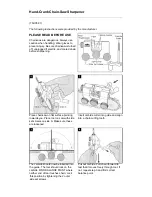
14
| English
1 609 92A 3X6 | (13.12.17)
Bosch Power Tools
Switch setting
1
is suitable for cooling down a heated work-
piece or for drying paint. It is also suitable for cooling down
the power tool before putting it down or changing the attach-
ment nozzles.
Saving airflow/temperature combinations (GHG 23-66)
You can save four airflow/temperature combinations or access
four saved preset combinations.
To do this, the on/off switch
4
must be set to switch position
2
.
To call up a combination, keep pressing the memory button
11
until the number you want appears in the display
5
.
To save your own combination:
– Press the memory button
11
to select the memory preset
you want.
– Set the desired temperature and airflow. The memory pre-
set
5
flashes to indicate that the saved combination has
been changed.
– Press and hold down the memory button
11
. The memory
preset
5
flashes for around two seconds. When it lights up
continuously, the new combination has been saved.
Working Advice
Before any work on the machine itself, pull the mains
plug.
Note:
Do not apply the nozzle
1
too close to the workpiece be-
ing worked. The hot air build-up can lead to overheating of the
power tool.
Removing the Heat Protection
When working in particularly tight spaces, you can remove the
heat shield
2
by turning it.
Be careful of the hot nozzle!
Increased danger of burning
exists when working without the heat protection collar.
To remove or mount the heat protection collar
2
, switch the
power tool off and allow it to cool down.
To speed up the cooling, the power tool can also be operated
for a short period with the lowest adjustable temperature.
Placing Down the Power Tool (see figures D and G)
To cool down the power tool or have both hands free, place it
down on the standing surface
3
.
Be especially careful when working with the placed
down power tool!
There is danger of burning oneself on
the hot nozzle or on the hot air jet.
Work Examples (see figures A–G)
The figures of the application examples can be found on the
graphics pages.
The distance between the nozzle and the workpiece depends
on the material you are working on (metal, plastic, etc.) and
the intended working method.
The optimum temperature for each application can be deter-
mined by a practical test.
Always test the amount of air and temperature first. Start at a
greater distance and a lower power setting. Then adjust the
distance and power setting according to requirements.
If you are unsure what material you are working on or what ef-
fect the hot air gun might have on it, first test the effect on a
concealed area.
All application examples can be performed without accesso-
ries except for “Strip paint from window frames”. However,
the use of recommended accessories simplifies the work and
significantly improves the quality of the result.
Be careful when changing the nozzle! Do not touch the
hot nozzle. Allow the power tool to cool down and wear
protective gloves while changing the nozzle.
Danger of
burning oneself on the hot nozzle.
Removing Varnish/Softening Adhesives (see figure A)
Fit the surface nozzle
14
(accessories). Briefly soften the
paint with hot air and remove it with a clean spatula. Long heat
exposure burns the paint and makes removal more difficult.
Many adhesives become soft when heated. Heated adhesives
allow for bonds to be separated or excessive adhesive to be
removed.
Strip paint from window frames (see figure B)
Use of the glass protection nozzle 15 (accessory) is
essential.
Danger of glass breaking.
On profiled surfaces, varnish can be removed using an appro-
priately fitting spatula and brushed off with a soft wire brush.
Defrosting Water Pipes (see figure C)
Before heating pipes, check to make sure that it is actu-
ally a water pipe.
Water lines often do not differ in appear-
ance from gas lines. Gas lines are not to be heated under
any circumstances.
Place on the angle nozzle
16
(accessory). Heat the frozen
zone always from the outside to the middle.
Heat up plastic pipes as well as connections between pipe
pieces especially careful to prevent damage.
Shaping Plastic Tubing (see figure D)
Fit the reflector nozzle
17
(accessories). Fill plastic pipes
with sand and seal them on both sides to prevent the pipe
bending. Carefully and evenly heat the pipe by moving the
tool back and forth from one side to the other.
Welding Plastics (see figure E)
Mount the reduction nozzle
20
and the welding shoe
19
(both
accessories). The workpieces to be welded and the welding
rod
18
(accessory) must be of the same material (e.g. both of
PVC). The seam must be clean and grease-free.
Factory Reset
Memory
preset
°C
l/min
Application
0*
50
150
– Cooling down a workpiece
– Drying paint
1
250
350
Shaping Plastic Tubing
2
350
400
Welding Plastics
3
450
500
Removing varnish
4
550
400
Soft Soldering
* not shown in the display
OBJ_BUCH-3211-001.book Page 14 Wednesday, December 13, 2017 11:58 AM















































